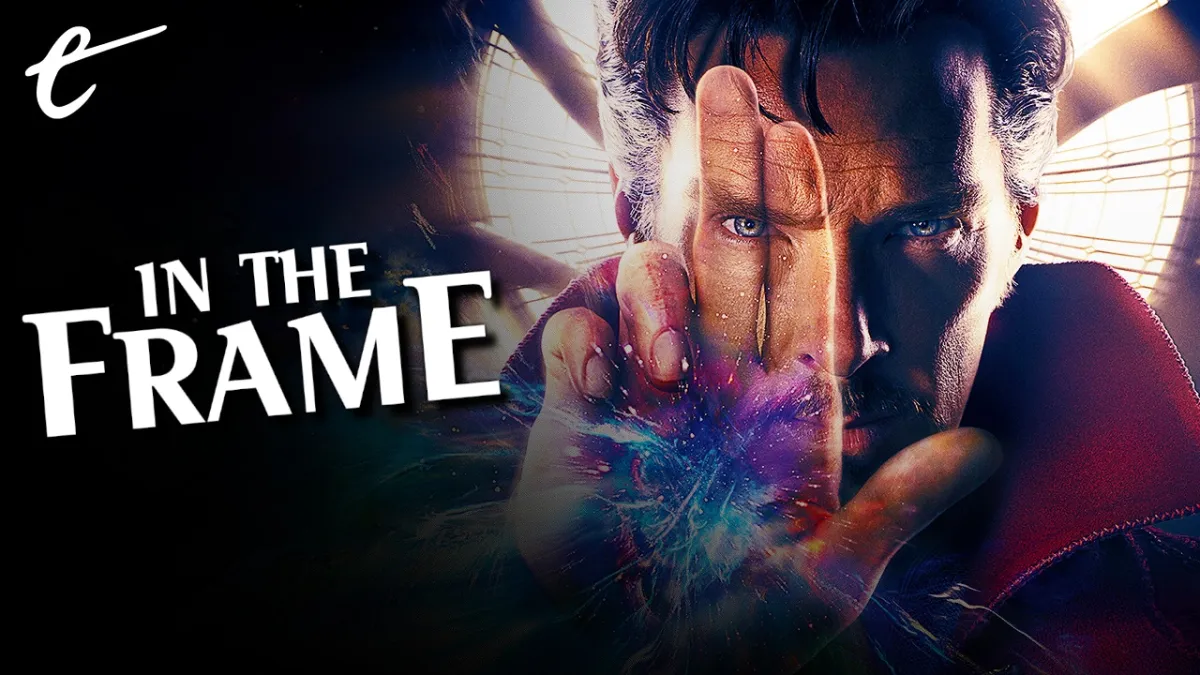With the release of Sam Raimi’s Doctor Strange in the Multiverse of Madness, it seems like a good opportunity to take a look back at Scott Derrickson’s Doctor Strange.
While Stephen Strange (Benedict Cumberbatch) has become an important figure in the shared Marvel Cinematic Universe, playing major roles in subsequent films like Avengers: Infinity War and Spider-Man: No Way Home, the character’s first cinematic appearance is somewhat overlooked. Doctor Strange opened to positive reviews; it sits squarely in the middle of the studio’s rankings on Rotten Tomatoes and on the edge of the top 10 rankings on Metacritic.
However, there is an appealing simplicity to Doctor Strange. It is a fairly straightforward superhero origin story built around the title character. Even more than Ant-Man, which was released the previous summer, the structure and rhythms of Doctor Strange hearken back to the conventional superhero origin stories of the earliest films in the MCU. The film itself is quite similar in tone to Kenneth Branagh’s Thor, while the basic character arc is similar to that of Jon Favreau’s Iron Man.
Notably, Doctor Strange plays its story straight down the middle, lacking a lot of the complications that defined many of the shared universe’s late-period superhero origins. Unlike in Ant-Man, there is no attempt to introduce the concept of legacy heroes into the shared universe. Unlike Black Panther, this is not a story picking up from the fallout of an earlier crossover. Unlike in Captain Marvel, there are no structural games or period-piece trappings to distract from the familiar storytelling engine.
There is something satisfying in this back-to-basics approach, particularly given that the MCU was becoming increasingly cluttered and convoluted. Doctor Strange was released between the crossover madness of Captain America: Civil War and the space opera domestic drama of Guardians of the Galaxy Vol. 2. As such, there was something to be said for the good, clean structural rhythms of a conventional and reliable superhero origin story.

That said, there are interesting ideas simmering beneath the surface of this familiar narrative template. At its core, Doctor Strange is the rare superhero movie that is obsessed with the idea of time and death, and it argues that these universal forces are not enemies to be defeated but realities to be understood. Doctor Strange is a story about how time and death are an inevitable and inescapable part of life and that efforts to forestall them are often both monstrous and grotesque.
From the outset, Doctor Strange is preoccupied with mortality. The film introduces Stephen Strange as a renowned neurosurgeon. Naturally, Strange is locked in a battle against death, fighting to forestall it. His once-girlfriend Christine Palmer (Rachel McAdams) informs him that rival neurosurgeon Nicodemus West (Michael Stuhlbarg) “diagnosed brain death” in a gunshot wound victim. Strange offers a “competent opinion,” discovering the patient isn’t actually dead.
In his introductory sequence, Strange performs what is tantamount to necromancy. He effectively brings a patient back to life, after that patient had been declared deceased. It is a moment of heroism, with Strange and Palmer getting to deliver the good news to the patient’s family, but it is also a defining moment. It immediately establishes Strange as a character struggling against the natural order of things, one defined by his refusal to accept the inevitability of death.
Like Iron Man before it, Doctor Strange is effectively a story of death and resurrection. In Iron Man, Tony Stark (Robert Downey Jr.) is horribly wounded during a terrorist ambush, damaging his heart. In a cave in Afghanistan, Stark literally rebuilds himself, emerging transformed and reborn. In Doctor Strange, the title character loses the use of his hands in a horrific car crash. He travels to Nepal, where he studies the mystic arts in the hope of recovering.

In Iron Man, Stark is able to return from Afghanistan and reclaim his old life. He reasserts control of his family business and uses his celebrity profile to claim the superhero title “Iron Man.” Even the damage to his heart is reversible, with the character undergoing surgery in Iron Man 3 to remove the shrapnel. Tony Stark dies and is reborn in Iron Man, but he can return to some semblance of his old life as a new and improved version of himself.
In contrast, Doctor Strange makes it clear that Strange can never go back to being the man that he once was. When the Ancient One (Tilda Swinton) calls him “Mister Strange,” he corrects her, “Doctor, actually.” She counters, “Well, no. Not anymore, surely.” After his injury, Strange becomes obsessed with trying to recapture what he once had. “Some things just can’t be fixed,” Palmer tells him. “This isn’t the end. There are other things that can give your life meaning.”
Late in the movie, realizing that his hands still shake even after learning how to use magic, the Ancient One reveals that Strange could use his powers to steady himself. “So, I could have my hands back again?” he asks. “My old life?” She replies, “You could. And the world would be all the lesser for it.” Strange starts Doctor Strange believing that he can return to the man he once was, but his journey is towards the understanding that this earlier version of himself is lost.
Doctor Strange returns time and again to the image of the watch. During that surgery on the gunshot wound victim, Strange becomes distracted by the ticking of West’s watch, a reminder of the passage of time. On the night of the car crash, Strange wears a standard tuxedo but chooses his watch from a drawer full of options. He is mugged in Nepal, by criminals trying to take his watch. “It’s all I have left,” he admits. The watch is broken in the struggle but returned to him. It becomes a keepsake.

Appropriately, the villain of Doctor Strange is a man who seeks to stop the passage of time and to cheat the inevitability of death. Kaecilius (Mads Mikkelsen) rages against the idea of entropy. “You understand the laws of nature,” he tells Strange. “All things age, all things die. In the end, our sun burns out, our universe grows cold and perishes.” He elaborates, “Time is the true enemy of us all. Time kills everything.” Marked by his own trauma, he argues, “Time is an insult. Death is an insult.”
Kaecilius wants to summon the Dread Dormammu (Cumberbatch) and unleash “the Dark Dimension” upon Earth. Dormammu rules over “a world beyond time, beyond death.” However, it is truly monstrous. This immortality corrupts anything that touches it. The Ancient One’s decision to tap into the power of the Dark Dimension to ensure her own immortality is what ultimately leads to the corruption of two of her best students: Kaecilius and Mordo (Chiwetel Ejiofor).
The result of all of this is an interesting superhero movie, one that seems to argue for the importance of death and decay as natural forces. The Ancient One’s final lesson to Strange is to embrace these inevitabilities rather than to fight them. “You want to go back to the delusion that you can control anything, even death, which no one can control,” she tells her last student. “It’s our fear of death that gives Dormammu life.” Immortality and eternity are curses.
It seems fitting then that Strange defeats Dormammu by catching him in “endless looped time.” Faced with the prospect of being “trapped in this moment, endlessly,” Dormammu surrenders and retreats. The final shot of Strange before the closing credits finds the character placing the broken watch on his wrist, a reminder of both the passage of time and the fact that nothing lasts forever. Things end so that new things can begin. There’s no need to fear time.

This was an important thematic point for the MCU at that moment in time. Comic books are a famously static medium, operating by an elastic internal chronology where the characters exist in a perpetual present without any real need for change or growth. Heroes exist in an eternal present, their pasts adjusting as needed. Was the Punisher a veteran of the Vietnam War or the Gulf War? Did the Vietnam War even happen in the comics, or was it another fictional conflict?
Movies don’t have the same luxury. Actors age and retire, forcing production teams to rotate casts. Tony Stark might appear in decades’ worth of comic books, but Robert Downey Jr. could only give so much of his life to the character. The MCU was grappling with this reality as Doctor Strange came out. Downey had wrapped up his Iron Man trilogy. Chris Evans had just finished his Captain America trilogy. Both actors would be departing the shared universe at the end of Avengers: Endgame.
This fixation on the passage of time and the inevitability of death makes Doctor Strange a spiritual companion to the previous year’s Avengers: Age of Ultron, which was largely about the challenge in translating these static characters to an evolving medium. Ironically, Doctor Strange premiered just a month before Rogue One demonstrated that computer-generated facsimiles of actors like Peter Cushing or Carrie Fisher could trap actors’ likenesses in amber beyond the ravages of time or death.
It’s interesting to revisit Doctor Strange in a world that has become even more obsessed with reviving and resurrecting the past, refusing to accept the passage of time and the need to move on. In Endgame, the MCU’s part becomes something of a theme park amusement, a funhouse hall of mirrors in which the audience and characters might lose themselves. In No Way Home, Strange is rendered an antagonist for trying to send nostalgic characters back to their point of origin.
If rumors are true, Doctor Strange in the Multiverse of Madness looks to indulge in nostalgia that extends well beyond the MCU, to recapture an idyllic past that reaches further back than Iron Man. If that is true, then it seems that maybe Kaecilius ultimately won.






Published: May 2, 2022 11:00 am